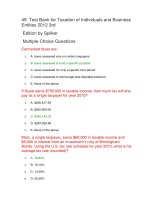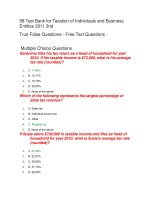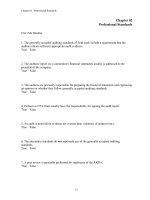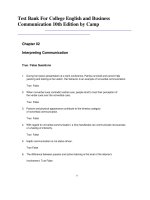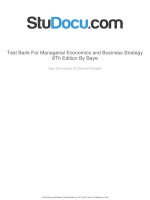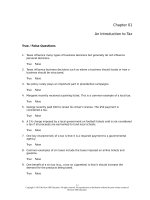Test bank taxation of individuals and business entities 2015 6e by brian c spilker chap007
Bạn đang xem bản rút gọn của tài liệu. Xem và tải ngay bản đầy đủ của tài liệu tại đây (1.76 MB, 116 trang )
Chapter 07
Individual Income Tax Computation and Tax Credits
True / False Questions
1. Both the width (or range) of the tax brackets (the amount of income taxed at a
particular rate) in the tax rate schedules and the range of the tax rates in the tax rate
schedules (the difference between the lowest tax rate and the highest tax rate) vary
by filing status.
True
False
2. The tax rate schedules are set up to tax lower levels of income at higher tax rates
than higher levels of income.
True
False
3. Tax rate schedules are provided for use by (relatively) higher income taxpayers while
the tax tables are provided for use by (relatively) lower income taxpayers.
True
False
4. If a married couple has one primary breadwinner, filing a joint return will likely result
in a marriage penalty.
True
False
5. If both spouses of a married couple earn roughly equivalent wages, the couple is
likely to pay a marriage penalty due to the nature of the tax rate schedules.
True
False
6. A marriage penalty occurs when a couple pays more taxes by filing a joint tax return
than they would have paid had they filed married filing separate returns.
True
False
7. All capital gains are taxed at preferential rates.
True
False
8. Long-term capital gains, dividends, and taxable interest income are all taxed at
preferential rates.
True
False
7-1
Copyright © 2015 McGraw-Hill Education. All rights reserved. No reproduction or distribution without the prior written consent of
McGraw-Hill Education.
9. Generally, income from an active trade or business is subject to the 3.8% Net
Investment Income tax.
True
False
10. In certain circumstances a child with very little income may have their income taxed
at the parents' marginal tax rate.
True
False
11. The kiddie tax does not apply to children over 24 years old at the end of the tax
year.
True
False
12. The alternative minimum tax system requires taxpayers to apply an alternative tax
rate on the regular income tax base to determine the amount of the alternative
minimum tax.
True
False
13. Regular taxable income is the starting point for determining the alternative minimum
tax.
True
False
14. The alternative minimum tax is the AMT base multiplied by the AMT rate.
True
False
15. Long-term capital gains are taxed at the stated AMT rate for purposes of the
alternative minimum tax.
True
False
16. Taxpayers are not allowed to deduct personal or dependency exemptions for
alternative minimum tax purposes.
True
False
17. For alternative minimum tax purposes, taxpayers are required to add back the
regular tax standard deduction amount for their filing status whether or not they
itemized deductions for regular tax purposes.
True
False
18. For alternative minimum tax purposes, taxpayers are allowed to deduct state income
taxes but are not allowed to deduct charitable contributions.
True
False
19. The AMT exemption amount is phased-out for high income taxpayers.
True
False
7-2
Copyright © 2015 McGraw-Hill Education. All rights reserved. No reproduction or distribution without the prior written consent of
McGraw-Hill Education.
20. All else equal, a reduction in regular income tax rates would require more taxpayers
to pay the alternative minimum tax.
True
False
21. Due to the alternative minimum tax rate structure, timing tax planning strategies are
not effective under the alternative minimum tax system.
True
False
22. Employees must pay both Social Security tax and Medicare tax on all of their wages
no matter the amount of their wages.
True
False
23. For married couples, the Social Security wage base limitation applies separately to
each spouse.
True
False
24. For married couples, the Medicare tax is based on the couple's combined wages.
True
False
25. Alton reported net income from his sole proprietorship of $90,000. To determine his
self employment tax, he would multiply $90,000 by the self-employment tax rate.
True
False
26. Employee status is always better than independent contractor status for a taxpayer
because the employee is responsible for paying the employee portion of the FICA
taxes.
True
False
27. Self-employed taxpayers are allowed to deduct the full amount of the selfemployment taxes they pay.
True
False
28. Employees are not allowed to deduct FICA taxes they pay.
True
False
29. Employees are allowed to deduct a portion of the FICA taxes they pay.
True
False
30. Katlyn reported $300 of net income from her sole proprietorship. She is not required
to pay self-employment tax.
True
False
7-3
Copyright © 2015 McGraw-Hill Education. All rights reserved. No reproduction or distribution without the prior written consent of
McGraw-Hill Education.
31. All else equal, taxpayers are more likely to be classified as employees rather than
independent contractors if they are allowed to determine their own working hours
and work without frequent oversight.
True
False
32. Tax credits reduce a taxpayer's taxable income dollar for dollar.
True
False
33. The child tax credit is subject to phase-out based on the taxpayer's AGI.
True
False
34. Parents may claim a child tax credit for a dependent child who is 22 years of age at
the end of the year if the child is a full-time student.
True
False
35. Parents may claim a child and dependent care credit for expenses incurred in
providing for their dependents while the parents work as long as the children are over
age 14 and under age 20 at year end.
True
False
36. John and Sally pay Janet (Sally's older sister) to watch John and Sally's child Dexter
during the day. Janet cares for Dexter in her home. John and Sally may claim a child
and dependent care credit based on the amount they pay Janet to care for Dexter.
True
False
37. The child and dependent care credit entitles qualifying taxpayers to a credit equal to
the full amount of qualified expenses.
True
False
38. The American opportunity credit is available only for those students who are in their
first or second year of postsecondary education.
True
False
39. The lifetime learning credit can be used toward the cost of any course of instruction
to acquire or improve a taxpayer's job skills, no matter the age of the taxpayer.
True
False
40. The American opportunity credit and lifetime learning credit are available to all
taxpayers regardless of their income level.
True
False
41. The earned income credit is sometimes referred to as a negative income tax.
True
False
7-4
Copyright © 2015 McGraw-Hill Education. All rights reserved. No reproduction or distribution without the prior written consent of
McGraw-Hill Education.
42. To qualify for the earned income credit, the taxpayer must have a qualified
dependent.
True
False
43. An 80-year-old taxpayer with earned income and no dependent children could qualify
for the earned income credit.
True
False
44. Business credits are generally refundable credits.
True
False
45. Taxpayers are generally allowed to carry back and/or carry forward unused business
credits.
True
False
46. When applying credits against a taxpayer's gross tax liability, nonrefundable personal
credits are applied first, then business credits, and finally refundable personal
credits.
True
False
47. An individual could pay 100% of her tax liability by the due date of her tax return and
still be subject to underpayment tax penalties.
True
False
48. Depending on the year, the original (unextended) due date for an individual's tax
return may be after April 15.
True
False
49. Depending on the year, the original (unextended) due date for an individual's tax
return may be before April 15.
True
False
50. Individuals may file for and receive a six-month extension of time to file their tax
return and pay their taxes without penalty.
True
False
51. The late payment penalty is based on the amount of tax owed and the number of
days that the tax is not paid. The maximum amount of the penalty is unlimited.
True
False
Multiple Choice Questions
7-5
Copyright © 2015 McGraw-Hill Education. All rights reserved. No reproduction or distribution without the prior written consent of
McGraw-Hill Education.
52. Which of the following is not a taxpayer filing status for purposes of determining the
appropriate tax rate schedule?
A. Head of
Household
B. Qualifying Widow or
Widower
C. Married Filing
Separately
D. Singl
e
E. All of these are taxpayer filing
statuses
53. The taxable income levels in the married filing jointly tax rate schedule are _______
those in the married filing separately schedule.
A. the same
as
B. doubl
e
C. half the
amount of
D. None of
these
54. Linda is a qualifying widow in 2014. In 2014, she reported $75,000 of taxable income
(all ordinary). What is her gross tax liability using the tax rate schedules?
A. $10,46
3
B. $14,60
6
C. $14,67
9
D. $13,16
3
7-6
Copyright © 2015 McGraw-Hill Education. All rights reserved. No reproduction or distribution without the prior written consent of
McGraw-Hill Education.
55. Miley, a single taxpayer, plans on reporting $27,900 of taxable income this year (all
of her income is from a part-time job). She is considering applying for a second parttime job that would give her an additional $10,000 of taxable income. By how much
will the income from the second job increase her tax liability (use the tax rate
schedules)?
A. $1,00
0
B. $1,50
0
C. $1,60
0
D. $2,50
0
56. Tamra and Jacob are married and they file a joint tax return. Tamra received nearly
five times the salary that Jacob received. Which of the following statements is true?
A. Tamra and Jacob likely pay no tax marriage penalty nor receive a tax
marriage benefit.
B. Tamra and Jacob likely pay a tax marriage
penalty.
C. Tamra and Jacob likely receive a tax marriage
benefit.
D. Tamra and Jacob likely will pay a tax marriage penalty and receive a tax
marriage benefit.
57. Stephanie and Mitch are married and they file a joint tax return. Mitch received a
slightly higher salary than Stephanie did during the year. Which of the following
statements is true?
A. Stephanie and Mitch likely pay no tax marriage penalty nor receive a tax
marriage benefit.
B. Stephanie and Mitch likely pay a tax marriage
penalty.
C. Stephanie and Mitch likely receive a tax marriage
benefit.
D. Stephanie and Mitch likely will pay a tax marriage penalty and receive a tax
marriage benefit.
7-7
Copyright © 2015 McGraw-Hill Education. All rights reserved. No reproduction or distribution without the prior written consent of
McGraw-Hill Education.
58. Harrison received a qualified dividend. Without knowing any additional facts, which of
the following statements is true regarding the rate at which the dividend will be taxed
to Harrison?
A. The dividend will be taxed at a 15%
tax rate.
B. The dividend will be taxed at a 20%
tax rate.
C. The entire dividend will be taxed at either 15% or the entire dividend will be taxed
at 20% depending on Harrison's marginal ordinary income tax rate.
D. None of
these.
59. Jamie is single. In 2014, she reported $100,000 of taxable income, including a longterm capital gain of $5,000. What is her gross tax liability, rounded to the nearest
whole dollar amount (use the tax rate schedules)?
A. $22,57
6
B. $21,17
6
C. $20,52
6
D. $15,00
0
60. Angelena files as a head of household. In 2014, she reported $50,000 of taxable
income, including a $10,000 qualified dividend. What is her gross tax liability,
rounded to the nearest whole dollar amount (use the tax rate schedules)?
A. $5,35
3
B. $5,44
3
C. $7,50
0
D. $6,91
3
7-8
Copyright © 2015 McGraw-Hill Education. All rights reserved. No reproduction or distribution without the prior written consent of
McGraw-Hill Education.
61. Allen Green is a single taxpayer with an AGI (and modified AGI) of $210,000, which
includes $170,000 of salary, $25,000 of interest income, $10,000 of dividends, and
$5,000 of long-term capital gains. What is Allen's Net Investment Income tax liability
this year, rounded to the nearest whole dollar amount?
A. $2,46
5
B. $1,52
0
C. $57
0
D. $38
0
62. Which of the following is not a barrier to income shifting among family members?
A. The assignment of income
doctrine
B. Net unearned income for children 18 and younger taxed at parents'
marginal tax rates
C. Elimination of preferential tax rates (on dividends and long-term capital gains) for
dependents
D. Two of
these
63. The Olympians have three children. The kiddie tax applies to unearned income
received by which of the following children?
A. Poseidon is a 20-year-old full-time student who does not
support himself
B. Demeter, a 23-year-old full-time student who supports herself with a job at a
grocery store
C. Zeus is 20 years old and not a
student
D. Two of
these.
E. None of
these.
7-9
Copyright © 2015 McGraw-Hill Education. All rights reserved. No reproduction or distribution without the prior written consent of
McGraw-Hill Education.
64. Assuming the kiddie tax applies, what amount of a child's income is subject to the
kiddie tax?
A. All of
it
B. All of the unearned
income
C. The net unearned
income
D. Taxable income less the standard
deduction
65. During 2014, Montoya (age 15) received $2,200 from a corporate bond. He also
received $600 from a savings account established for him by his parents. Montoya
lives with his parents and he is their dependent. What is Montoya's taxable income?
A. $
0
B. $2,20
0
C. $2,80
0
D. $1,80
0
66. During 2014, Jasmine (age 12) received $2,400 from a corporate bond. She also
received $600 from a savings account established for her by her parents. Jasmine
lives with her parents and she is their dependent. Assuming her parents' marginal tax
rate is 28%, what is Jasmine's gross tax liability?
A. $
0
B. $10
0
C. $28
0
D. $38
0
7-10
Copyright © 2015 McGraw-Hill Education. All rights reserved. No reproduction or distribution without the prior written consent of
McGraw-Hill Education.
67. Hestia (age 17) is claimed as a dependent by her parents, Rhea and Chronus. In
2014, Hestia received $1,000 of interest income from a corporate bond that she
owns. In addition, she has earned income of $200. What is her taxable income for
2014?
A. $
0
B. $20
0
C. $65
0
D. $1,20
0
68. Montague (age 15) is claimed as a dependent by his parents Matt and Mary. In 2014,
Montague received $5,000 of qualified dividends and he received $800 from a part
time job. What is his taxable income for 2014?
A. $
0
B. $3,80
0
C. $4,65
0
D. $4,80
0
69. Hester (age 17) is claimed as a dependent by his parents, Charlton and Abigail. In
2014, Hester received $10,000 of qualified dividends and he received $6,000 from a
part time job. What is his taxable income for 2014?
A. $16,00
0
B. $15,00
0
C. $9,80
0
D. $9,65
0
7-11
Copyright © 2015 McGraw-Hill Education. All rights reserved. No reproduction or distribution without the prior written consent of
McGraw-Hill Education.
70. The alternative minimum tax base is typically ______ the regular income tax base.
A. smaller
than
B. about the same
as
C. larger
than
D. exactly the same
as
71. The computation of the alternative minimum tax base begins with regular taxable
income. Which of the following is not part of the formula for computing the
alternative minimum tax base?
A. Subtract personal
exemptions
B. Add the standard deduction amount if used for
regular tax
C. Subtract the AMT exemption amount
(if any)
D. Add back tax exempt interest from a private activity bond not issued in
2009 or 2010.
72. In 2014, Maia (who files as a head of household) reported regular taxable income of
$115,000. She itemized her deductions, deducting $8,000 in charitable contributions
and $3,000 in state income taxes. She claimed exemptions for herself and her son,
Hermes, ($3,900 each). What is Maia's alternative minimum taxable income?
A. $118,00
0
B. $126,00
0
C. $133,90
0
D. $125,90
0
73. Which of the following items is not added back to regular taxable income in
computing alternative minimum taxable income?
A. Home mortgage interest
expense
B. Real property
taxes
C. Tax exempt interest from a private activity bond issued
in 2007
D. Miscellaneous itemized deductions in excess of the
2% floor
7-12
Copyright © 2015 McGraw-Hill Education. All rights reserved. No reproduction or distribution without the prior written consent of
McGraw-Hill Education.
74. Which of the following statements regarding the AMT exemption amounts is not
true?
A. The amount of the exemption depends on the taxpayer's
filing status.
B. The exemption amount is completely phased-out for high income
taxpayers.
C. Taxpayers must choose whether they will claim the exemption or itemize
deductions.
D. None of these statements is false (All of these statements
are true).
75. Persephone has a regular tax liability of $12,475 and a tentative minimum tax of
$11,500. Given just this information, what is her alternative minimum tax liability for
the year?
A. $
0
B. $11,50
0
C. $97
5
D. $12,47
5
76. Harmony reports a regular tax liability of $15,000 and tentative minimum tax of
$17,000. Given just this information, what is her alternative minimum tax liability for
the year?
A. $
0
B. $2,00
0
C. $15,00
0
D. $17,00
0
77. Which of the following statements accurately describes the alternative minimum tax
rate(s)?
A. The top AMT marginal rate is higher than the top regular tax
marginal tax rate.
B. The AMT rates represent a progressive tax rate
structure.
C. The AMT rate is the same rate for all
taxpayers.
D. None of
these.
7-13
Copyright © 2015 McGraw-Hill Education. All rights reserved. No reproduction or distribution without the prior written consent of
McGraw-Hill Education.
78. Which of the following is not typical of taxpayers who are most likely affected by the
AMT?
A. Have many
dependents
B. Pay high state income
tax
C. Pay high property
taxes
D. Have relatively low capital
gains
79. Which of the following could explain why large number of taxpayers are subject to (or
could become subject to) AMT?
A. Regular tax rates have decreased since the AMT was
enacted
B. The AMT exemption amount is indexed to increase with
inflation
C. Property values are
decreasing
D. The personal and dependency exemption amounts are not increasing as fast as the
AMT exemption is decreasing
80. Asteria earned a $25,500 salary as an employee in 2014. How much should her
employer have withheld from her paycheck for FICA taxes (rounded to the nearest
whole dollar amount)?
A. $37
0
B. $1,58
1
C. $1,95
1
D. $3,90
2
81. Baker earned $225,000 of salary as an employee in 2014. How much should his
employer have withheld from his paycheck for FICA taxes (rounded to the nearest
whole dollar amount)?
A. $10,74
2
B. $10,51
7
C. $7,25
4
D. $17,21
3
7-14
Copyright © 2015 McGraw-Hill Education. All rights reserved. No reproduction or distribution without the prior written consent of
McGraw-Hill Education.
82. Hera earned $175,000 salary in 2014. Her husband, Zeus, earned $100,000 salary in
2014. Hera and Zeus file a joint tax return. How much FICA taxes will they owe in
2014?
A. $21,26
3
B. $17,66
7
C. $13,45
4
D. $4,21
3
83. Which of the following statements regarding FICA taxes is true?
A. Low income employees are not required to pay FICA
taxes.
B. An employee who has two different employers during the year may be entitled to a
tax credit for overpaid FICA taxes.
C. The maximum amount of Medicare taxes an employee is required to pay is capped
each year but the maximum amount of Social Security taxes is not.
D. The wage base limit for Social Security taxes depends on the taxpayer's
filing status.
84. Which of the following suggests that a working taxpayer is an independent contractor
rather than an employee?
A. Works for more than one
firm
B. May realize a loss from business
activities
C. Sets own working
hours
D. Works somewhere other than on employer
premises
E. All of these suggest independent contractor
status
85. Which of the following statements best describes the deductions independent
contractors may claim for valid business expenses?
A. for AGI
deductions
B. from AGI deductions not subject to the two percent of
AGI floor
C. from AGI deductions subject to a two percent of
AGI floor
D. for AGI deductions limited to income from the business
activities
7-15
Copyright © 2015 McGraw-Hill Education. All rights reserved. No reproduction or distribution without the prior written consent of
McGraw-Hill Education.
86. The wage base for which of the following taxes is capped?
A. Federal
income
B. Social
Security
C. Medicar
e
D. Alternative
minimum
87. Which of the following statements regarding the self-employment tax is most
accurate?
A. The self-employment tax base is generally the taxpayer's net income from selfemployment (usually net income from Schedule C).
B. Taxpayers who report less than $600 of net income from self-employment (usually
net income from Schedule C) are not required to pay self employment taxes.
C. The self-employment tax base is net earnings from self employment which is less
than net income from self-employment.
D. The Social Security tax limit does not apply to selfemployment taxes.
88. Which of the following best describes the manner in which self-employed taxpayers
may deduct self-employment taxes?
A. Deduct employer portion from
AGI.
B. Deduct entire amount from
AGI.
C. Deduct employer portion for
AGI.
D. Deduct entire amount for
AGI.
E. No
deduction
89. For taxpayers who receive both salary as an employee and self-employment income
as an independent contractor in the same year, which of the following statements
regarding FICA and self-employment taxes is most accurate?
A. The Social Security limit applies to the salary but not to the selfemployment income.
B. The Social Security limit applies to the self-employment income but not to
the salary.
C. Salary is first applied against the Social Security limit and then self-employment
income is applied against the Social Security limit.
D. Self-employment income is first applied against the Social Security limit and then
salary is applied against the Social Security limit.
7-16
Copyright © 2015 McGraw-Hill Education. All rights reserved. No reproduction or distribution without the prior written consent of
McGraw-Hill Education.
90. Which of the following statements concerning differences between employees and
independent contractors is most accurate?
A. Employees and independent contractors deduct business expenses as
miscellaneous itemized deductions.
B. While employees are typically eligible for nontaxable fringe benefits from
employers, independent contractors are not.
C. Employers are required to withhold either FICA or self employment taxes from
compensation paid to employees and compensation paid to independent
contractors.
D. Employers typically withhold federal income taxes from compensation paid to
employees and to independent contractors.
91. Which of the following statements concerning tax credits is true?
A. The tax benefit a taxpayer receives from a credit depends on the taxpayer's
marginal tax rate.
B. Refundable tax credits are limited to a taxpayer's gross
tax liability.
C. Tax credits are generally more beneficial than tax
deductions.
D. None of these is a true
statement.
92. Which of the following is not one of the general tax credit categories?
A. Nonrefundable
personal
B. Refundable
personal
C. Busines
s
D. Refundable
business
93. Which of the following statements regarding the child tax credit is false?
A. The child for whom the credit is claimed must be under the age of 15 at the
end of the year
B. The credit is subject to phase-out based on the
taxpayer's AGI
C. The full credit for a child who qualifies is
$1,000
D. The child for whom the credit is claimed must meet the definition of a
qualifying child
7-17
Copyright © 2015 McGraw-Hill Education. All rights reserved. No reproduction or distribution without the prior written consent of
McGraw-Hill Education.
94. Quantitatively, what is the relationship between the AGI phase-out thresholds for the
child tax credit?
A. Head of household/Single = Married Filing Separately = Married
Filing Jointly
B. Head of household/Single < Married Filing Separately < Married
Filing Jointly
C. Head of household/Single = Married Filing Separately > Married
Filing Jointly
D. Head of household/Single > Married Filing Separately < Married
Filing Jointly
95. Rhianna and Jay are married filing jointly in 2014. They have six children for whom
they may claim the child tax credit. Their AGI was $123,440. What amount of child
tax credit may they claim on their 2014 tax return?
A. $5,30
0
B. $6,00
0
C. $12,00
0
D. $4,00
0
96. The amount of expenditures eligible for the child and dependent care credit is the
least of three amounts. Which of the following is not one of those amounts?
A. The total amount of child and dependent care expenditures
for the year
B. $3,000 for one qualifying person or $6,000 for two or more
qualifying persons
C. The dependent's earned income for
the year
D. The taxpayer's earned income for
the year
97. Which of the following statements regarding the child and dependent care credit is
false?
A. Taxpayers may claim a credit for only a portion of qualifying dependent care
expenditures.
B. If a taxpayer's income is too high, she will be ineligible to claim any child and
dependent care credit.
C. A single taxpayer must have earned income to claim any child and dependent
care credit.
D. A taxpayer is not eligible to claim the dependent care credit if any dependent
relative provides the care.
7-18
Copyright © 2015 McGraw-Hill Education. All rights reserved. No reproduction or distribution without the prior written consent of
McGraw-Hill Education.
98. Trudy is Jocelyn's friend. Trudy looks after Jocelyn's four-year-old son during the day
so Jocelyn can go to work. During the year, Jocelyn paid Trudy $4,000 to care for her
son. What is the amount of Jocelyn's child and dependent care credit if her AGI for the
year was $30,000?
A. $
0
B. $81
0
C. $1,08
0
D. $3,00
0
99. Kaelyn's mother, Judy, looks after Kaelyn's four-year-old twins so Kaelyn can go to
work (she drops off and picks up the twins from Judy's home every day). Since Judy is
a relative, Kaelyn made sure, for tax purposes, to pay her mother the going rate for
child care ($6,300 for the year). What is the amount of Kaelyn's child and dependent
care credit if her AGI for the year was $36,000?
A. $1,44
0
B. $2,10
0
C. $6,00
0
D. $
0
100 Which of the following statements regarding the child and dependent care credit is
.
true?
A. A married couple must file jointly to claim
the credit.
B. A taxpayer may claim a credit for dependent care expenses for a dependent who
is 14 years old or older but only if the dependent lives in the taxpayer's home for
the entire year.
C. All else equal, a taxpayer making qualifying expenditures for three children may
claim more dependent care credit than a taxpayer making (the same amount of)
qualifying expenditures for two children.
D. None of these statements is
true.
7-19
Copyright © 2015 McGraw-Hill Education. All rights reserved. No reproduction or distribution without the prior written consent of
McGraw-Hill Education.
101 Which of the following is not true of the American opportunity credit?
.
A. A taxpayer with multiple eligible dependents can claim a credit for each
dependent's qualifying expenses
B. The credit is available for students during their first four years of postsecondary
education only
C. It is phased out based on the
taxpayer's AGI
D. A taxpayer may not claim a credit unless the taxpayer pays a dependent's
qualifying educational expenses
102 Which of the following is not true of the lifetime learning credit?
.
A. It is a nonrefundable
credit.
B. The credit can be claimed by taxpayers who have graduated from college and are
taking professional training courses to improve their job skills.
C. A taxpayer with multiple dependents can claim a credit for each dependent's
qualifying expenses.
D. The credit is subject to phase out based on the
taxpayer's AGI.
103 Which of the following is not a true statement about the American opportunity credit
.
(AOC) and lifetime learning credits?
A. A taxpayer may not report both an AOC and a lifetime learning credit on the
same tax return
B. Certain educational expenses qualify for both credits but taxpayers must claim
one credit or the other for the expenditures (the taxpayer cannot claim both
credits for the same expenditures)
C. Taxpayers may choose to either (1) deduct qualifying education expenses of an
individual as for AGI deductions or claim educational credits for the individual's
expenses (but not both)
D. The AGI phase-out threshold for phasing out the AOC is higher than the AGI phaseout threshold for the lifetime learning credit.
104 Which of the following statements regarding the earned income credit is true?
.
A. It is a nonrefundable
credit
B. It is possible that a taxpayer with more earned income may receive more credit
than a taxpayer with less earned income
C. A 70-year-old taxpayer with no dependents can qualify for the credit in certain
circumstances
D. A taxpayer whose only source of income is interest from corporate bonds is
eligible for the credit
7-20
Copyright © 2015 McGraw-Hill Education. All rights reserved. No reproduction or distribution without the prior written consent of
McGraw-Hill Education.
105 Which of the following does not affect the amount of the earned income credit?
.
A. Filing
status
B. Amount of credit taken in previous
years
C. Number of qualifying
children
D. Taxpayer's
AGI
106 Carolyn has an AGI of $38,000 (all from earned income), two qualifying children, and
.
is filing as a head of household. What amount of earned income credit is she entitled
to?
A. $
0
B. $1,21
2
C. $3,30
5
D. $4,24
8
E. $5,46
0
107 Which of the following statements regarding credits is correct?
.
A. Business expenses are generally refundable
credits
B. Business credits that are generated in one year but are not utilized in that
year expire
C. Business credits that are generated in one year but are not utilized in that year
may be carried forward to future years but not back to a prior year
D. Business credits that are generated in one year but are not utilized in that year
may be carried back to the previous year and then forward to future years
108 If there is not enough gross tax liability to use the foreign tax credit, __________.
.
A. it expires
unused
B. it is carried back 2 years or forward 20
years
C. it is carried back 3 years or forward 5
years
D. it is carried back 1 year or forward 10
years
7-21
Copyright © 2015 McGraw-Hill Education. All rights reserved. No reproduction or distribution without the prior written consent of
McGraw-Hill Education.
109 Which of the following tax credits is fully refundable?
.
A. American opportunity
credit
B. Dependent care
credit
C. Earned income
credit
D. None of
these
110 How could an individual obtain a business tax credit?
.
A. Through self-employment
activities
B. Through flow-through from a partnership or S
corporation
C. By working overseas and obtaining a foreign
tax credit
D. All of
these
111 Which of the following represents the correct order in which credits are applied to
.
gross tax liability (from first to last)?
A. Nonrefundable personal, business,
refundable
B. Business, nonrefundable personal,
refundable
C. Refundable, nonrefundable personal,
business
D. Refundable, business, nonrefundable
personal
112 Cassy reports a gross tax liability of $1,000. She also claims $400 of nonrefundable
.
personal credits, $700 of refundable personal credits, and $200 of business credits.
What is Cassy's tax refund or tax liability due after applying the credits?
A. $1,000 taxes
payable
B. $0 refund or taxes
payable
C. $700
refund
D. $300
refund
7-22
Copyright © 2015 McGraw-Hill Education. All rights reserved. No reproduction or distribution without the prior written consent of
McGraw-Hill Education.
113 Sheryl's AGI is $250,000. Her current tax liability is $52,068. Last year, her tax
.
liability was $48,722. She will not owe underpayment penalties if her total estimated
tax payments are at least which of the following (rounded) amounts (assume she
makes the required payments each quarter)?
A. $46,86
1
B. $48,72
2
C. $51,54
7
D. $53,59
4
114 If an employer withholds taxes from an employee, in general, when are these taxes
.
treated as paid to the IRS?
A. As
withheld
B. As the employee requests on his/her W4 form
C. Evenly throughout the
year
D. On April
15
115 Which of the following statements about estimated tax payments and underpayment
.
penalties is true for individual taxpayers?
A. Taxpayers who have paid their full tax liability by the original tax return due date
are protected from underpayment penalties.
B. Taxpayers who have paid their full tax liability by the extended tax return due date
are protected from underpayment penalties.
C. Taxpayers who have uneven income streams can pay estimated tax quarterly in
uneven amounts and not be susceptible to underpayment penalties.
D. Taxpayers who have paid their required amount of estimated tax, even though not
on time, are protected from underpayment penalties.
7-23
Copyright © 2015 McGraw-Hill Education. All rights reserved. No reproduction or distribution without the prior written consent of
McGraw-Hill Education.
116 Which of the following statement(s) concerning estimated tax payments and
.
underpayment penalties for individuals is (are) true?
A. Whether taxpayers are subject to underpayment penalties is determined on a
quarterly basis.
B. Due dates for estimated tax payments for a given year are April 15, June 15,
September 15 of that year and January 15 of the next year unless these dates fall
on a weekend or a holiday.
C. The amount of penalty depends on the amount of the underpayment among
other factors.
D. All of these statements are
true.
117 What happens if the taxpayer owes an underpayment penalty, but does not compute
.
it on Form 2210?
A. Nothing, unless the taxpayer is
audited
B. The taxpayer is immediately sent to the Tax
Court
C. The IRS will compute and assess the
penalty
D. The penalty is increased by five percentage
points
7-24
Copyright © 2015 McGraw-Hill Education. All rights reserved. No reproduction or distribution without the prior written consent of
McGraw-Hill Education.
118 Happy, Sleepy, Grumpy, and Doc all did not make adequate estimated payments.
.
Which of them will not owe underpayment penalties for 2014 given the following
information?
A. Happ
y
B. Sleep
y
C. Grump
y
D. Do
c
E. Two of
these
F. None of
these
119 Taxpayers are not required to file a tax return unless their gross income passes a
.
certain threshold. This threshold is generally the ________.
A. applicable standard deduction
amount
B. personal exemption
amount
C. twice the applicable standard deduction
amount
D. applicable standard deduction amount plus the personal
exemption amount
120 Why would a taxpayer file a tax return if not required to do so?
.
A. to remain in favor with the
IRS
B. to claim a refund of taxes
paid
C. all taxpayers are required to file
returns
D. in order to claim the standard
deduction
7-25
Copyright © 2015 McGraw-Hill Education. All rights reserved. No reproduction or distribution without the prior written consent of
McGraw-Hill Education.
